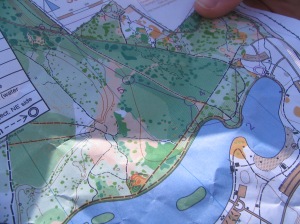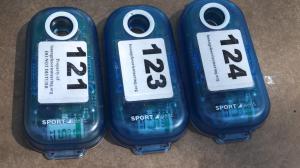 If you have never been orienteering, Google it right now. Find a club in your area. This is a great way to get outdoors, have fun, meet new people and boost your navigation skills. Orienteering is a sport (or game, depending on your perspective) that originated as a training exercise for Scandinavian military units in the early 20th century. You get a compass and a topo map of the area that is highly detailed. If one inch is a kilometer on your average USGS topo, one inch is about 100 yards on these. They have mapped every boulder and tree cluster, every signpost and outhouse. On this map are designated targets called “controls”.
If you have never been orienteering, Google it right now. Find a club in your area. This is a great way to get outdoors, have fun, meet new people and boost your navigation skills. Orienteering is a sport (or game, depending on your perspective) that originated as a training exercise for Scandinavian military units in the early 20th century. You get a compass and a topo map of the area that is highly detailed. If one inch is a kilometer on your average USGS topo, one inch is about 100 yards on these. They have mapped every boulder and tree cluster, every signpost and outhouse. On this map are designated targets called “controls”.
They are numbered, and you must locate all of them in numerical order. And it’s timed. You have three hours to complete the course, best time wins. There are courses from beginner to expert level, and the distance and elevation gain increase with each level. Competitors range from families with kids as young as seven to double-Olympic gold medalists. While athletic ability can help you move through the course faster, it counts for nothing if you have poor map skills. This is the only sport where I could potentially turn in a better time than Usain Bolt.
The LA Orienteering Club recently held and event at Mt. Pinos, about 90 minutes from LA, and I was itching to go. I had been orienteering twice before, but had always done the beginner adult course (Yellow) and always with a group. The courses had largely followed distinct trails and major landmarks. I was eager to try the next level up(Orange), in which cross-country navigation and land feature recognition become much more important. And I would be competing as an individual for the first time. I registered online ($33 for a competitive course, two training courses, an electronic punchstick, and a spot in the group campsite). Upon arrival, I received a number and an e-stick. Even Orienteering is going high tech, with a small electronic stick that you insert into each control. It helps the officials be sure that you ran the course in order and will give you a printout of your split times for each control. Plus it makes a happy beeping sound when you find a control.

E-punch boxes are numbered so you know which one is yours. Remember, it is not your control simply because you wish it to be.
It was about 90 degrees outside, and we were at 7000′ in the mountains of Los Padres National Forest. My course was about two miles long, and had 600 feet of elevation gain, presuming I ran it in straight lines. I am a terrible runner at sea level, so I was relying on my nav to get me through on time. I had learned from my previous experiences. I knew the scale would throw me off, so I use what I know, envisioning every inch on the map as a football field. But I soon fell into my biggest fault: if I find one control quickly, I get amped up and take off for the next one without really reading the map. The first four controls went well, then poorly, then well, then poorly, with many stops to relocate. Relocating is a technique in which, knowing you are in the wrong place, you backtrack to a known location and try again. Sort of like an orienteering Do Over. Usually, beginners put this off far too long and waste time crashing around the forest. I am no exception. A good orienteer can locate a control within a few minutes. On average, I locate one in ten minutes. Control number five took me an hour and seven minutes to locate. I got thrown off by multiple intersecting trails and convinced myself I was somewhere other than where I was. I swear I found controls for every course but mine, and the only relocation spot I had was the confusing trail junction. The epiphany came when I looked down my control list and found I had already located control number six forty-five minutes earlier. Because it wasn’t the number I was looking for, I had dismissed it. I quickly ran to it, navigated backward and finally found number five. After that, I was a lot less cocky and far more efficient, going slowly to go quickly. Despite the setback, I finished in the allotted time with 2 hours, 47 minutes.
After lunch and chugging much Gatorade, I tried a couple of training courses. One was called a “Donut O”. In which a perimeter around each control is whited out on the map (diabolical). The other was a “Night O” (dear Lord!). I almost chickened out of the night course. We were driven to the top of the mountain and told that we would finish back in the campground three miles away. Presuming, of course, that we navigated correctly. I did the beginner course which basically followed a trail, but you had to know when to get off to find the controls, all of which seemed to be off the trail just past the throw of a headlamp. I had also learned during the day not to follow other people. They may not be running your course for a start, and just because they are sprinting doesn’t mean they know where they’re going. I got onto the right trail (pretty sure), and red flags started going off in my head. It was dark, I was in a strange place, alone, and bailing out to the road would require going cross-country in steep terrain. Everything in me shouted, “This is stupid!”. Then I saw the reflective running shoes of someone up ahead. He was a solo beginner as well, and the two of us formed a kind of alliance. He was great at knowing when we had gone too far, and I was much better at reading terrain. We made a good team, and with the comfort of having a buddy, we found every control and made it back to camp in two hours!
I had a blast, and the members of LAOC were fun, helpful and welcoming. I recommend it to anyone, with following advice: Be willing to admit that it might be time to relocate, and do night courses with a buddy. Now go get lost! I promise you’ll have a great time.
Stay Wild!
LAOC: http://losangelesorienteering.org/drupal/
BAOC (Bay Area): http://baoc.org/wiki/Welcome
SDOC (San Diego): http://www.sandiegoorienteering.org/
USA Orienteering: http://www.us.orienteering.org/


